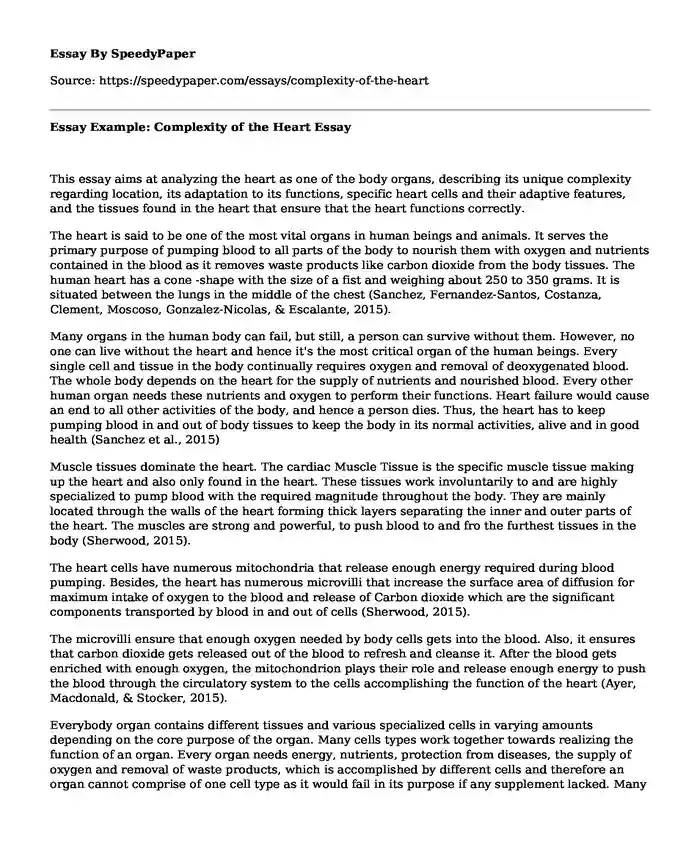This essay aims at analyzing the heart as one of the body organs, describing its unique complexity regarding location, its adaptation to its functions, specific heart cells and their adaptive features, and the tissues found in the heart that ensure that the heart functions correctly.
The heart is said to be one of the most vital organs in human beings and animals. It serves the primary purpose of pumping blood to all parts of the body to nourish them with oxygen and nutrients contained in the blood as it removes waste products like carbon dioxide from the body tissues. The human heart has a cone -shape with the size of a fist and weighing about 250 to 350 grams. It is situated between the lungs in the middle of the chest (Sanchez, Fernandez-Santos, Costanza, Clement, Moscoso, Gonzalez-Nicolas, & Escalante, 2015).
Many organs in the human body can fail, but still, a person can survive without them. However, no one can live without the heart and hence it's the most critical organ of the human beings. Every single cell and tissue in the body continually requires oxygen and removal of deoxygenated blood. The whole body depends on the heart for the supply of nutrients and nourished blood. Every other human organ needs these nutrients and oxygen to perform their functions. Heart failure would cause an end to all other activities of the body, and hence a person dies. Thus, the heart has to keep pumping blood in and out of body tissues to keep the body in its normal activities, alive and in good health (Sanchez et al., 2015)
Muscle tissues dominate the heart. The cardiac Muscle Tissue is the specific muscle tissue making up the heart and also only found in the heart. These tissues work involuntarily to and are highly specialized to pump blood with the required magnitude throughout the body. They are mainly located through the walls of the heart forming thick layers separating the inner and outer parts of the heart. The muscles are strong and powerful, to push blood to and fro the furthest tissues in the body (Sherwood, 2015).
The heart cells have numerous mitochondria that release enough energy required during blood pumping. Besides, the heart has numerous microvilli that increase the surface area of diffusion for maximum intake of oxygen to the blood and release of Carbon dioxide which are the significant components transported by blood in and out of cells (Sherwood, 2015).
The microvilli ensure that enough oxygen needed by body cells gets into the blood. Also, it ensures that carbon dioxide gets released out of the blood to refresh and cleanse it. After the blood gets enriched with enough oxygen, the mitochondrion plays their role and release enough energy to push the blood through the circulatory system to the cells accomplishing the function of the heart (Ayer, Macdonald, & Stocker, 2015).
Everybody organ contains different tissues and various specialized cells in varying amounts depending on the core purpose of the organ. Many cells types work together towards realizing the function of an organ. Every organ needs energy, nutrients, protection from diseases, the supply of oxygen and removal of waste products, which is accomplished by different cells and therefore an organ cannot comprise of one cell type as it would fail in its purpose if any supplement lacked. Many cell types have the advantage of working in unison in helping the body activities usually run. Every cell has its specific function that is always important to another cell in assisting an organ in performing its function (Ayer, Macdonald, & Stocker, 2015).
In conclusion, the heart has many different cell types that collectively work in helping the heart pump blood. The heart plays the central role in keeping the other body organs running hence keeping the mammalian body alive and healthy.
References
Ayer, A., Macdonald, P., & Stocker, R. (2015). CoQ10 function and role in heart failure and ischemic heart disease. Annual review of nutrition, 35, 175-213.
Sanchez, P. L., Fernandez-Santos, M. E., Costanza, S., Clement, A. M., Moscoso, I., Gonzalez-Nicolas, M. A., & Escalante, J. L. (2015). Acellular human heart matrix: a critical step toward whole heart grafts. Biomaterials, 61, 279-289.
Sherwood, L. (2015). Human physiology: from cells to systems. Cengage Learning.
Cite this page
Essay Example: Complexity of the Heart. (2022, Mar 22). Retrieved from https://speedypaper.net/essays/complexity-of-the-heart
Request Removal
If you are the original author of this essay and no longer wish to have it published on the SpeedyPaper website, please click below to request its removal:
- Essay Sample on Health Challenges Faced by an Immigrant Child
- Information Technology Thesis - Free Essay
- Essay Sample: Case Study for a Rotator Cuff Injury
- Free Essay Example: Psychological Theory and Practice
- Free Essay Example on the Autism-Vaccine Controversy
- Free Essay Including a Comparison of Lao-Tzu's and Machiavelli's Views of Government
- Essay Example: Frankenstein Critical Analysis Evaluation
Popular categories





